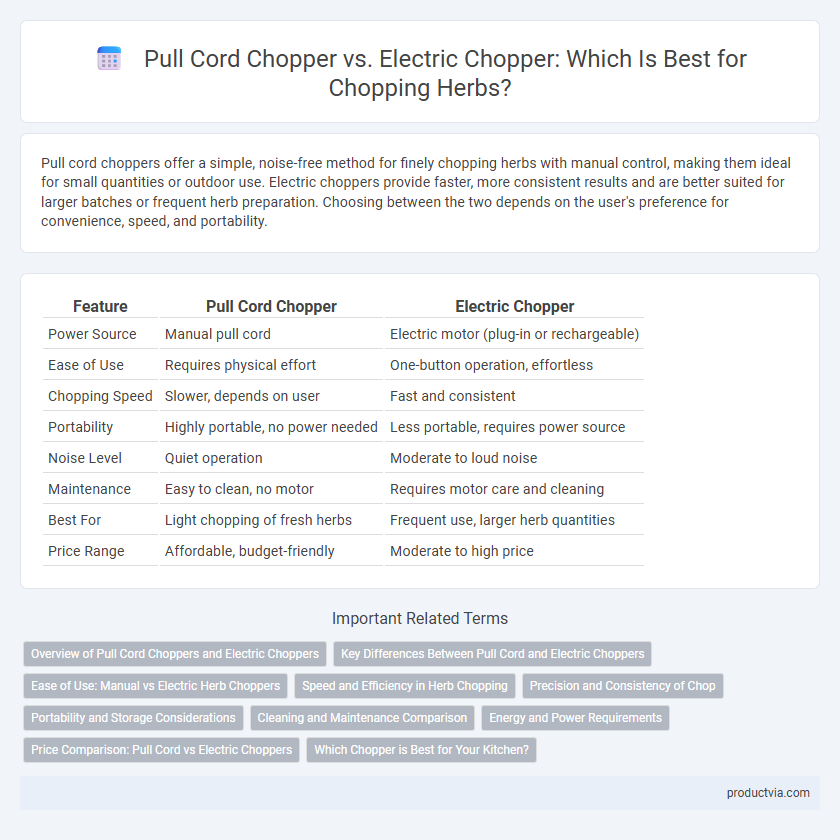Pull cord choppers offer a simple, noise-free method for finely chopping herbs with manual control, making them ideal for small quantities or outdoor use. Electric choppers provide faster, more consistent results and are better suited for larger batches or frequent herb preparation. Choosing between the two depends on the user's preference for convenience, speed, and portability.
Table of Comparison
| Feature | Pull Cord Chopper | Electric Chopper |
|---|---|---|
| Power Source | Manual pull cord | Electric motor (plug-in or rechargeable) |
| Ease of Use | Requires physical effort | One-button operation, effortless |
| Chopping Speed | Slower, depends on user | Fast and consistent |
| Portability | Highly portable, no power needed | Less portable, requires power source |
| Noise Level | Quiet operation | Moderate to loud noise |
| Maintenance | Easy to clean, no motor | Requires motor care and cleaning |
| Best For | Light chopping of fresh herbs | Frequent use, larger herb quantities |
| Price Range | Affordable, budget-friendly | Moderate to high price |
Overview of Pull Cord Choppers and Electric Choppers
Pull cord choppers use a manual mechanism where a cord is pulled to rotate the blades, offering portability and no reliance on electricity, making them ideal for small herb quantities. Electric choppers feature an electric motor that provides quick, consistent chopping power and are suitable for larger volumes or frequent use. Both types vary in blade sharpness, capacity, and ease of cleaning, influencing their effectiveness for herb preparation.
Key Differences Between Pull Cord and Electric Choppers
Pull cord choppers operate manually, relying on a spring mechanism activated by pulling a cord, making them cordless and ideal for small quantities of herbs with low maintenance needs. Electric choppers use a motor powered by electricity or batteries, offering faster, consistent chopping suitable for larger volumes or frequent use. Key differences include power source, chopping speed, ease of use, and capacity, with electric models providing more efficiency but requiring access to power and higher maintenance.
Ease of Use: Manual vs Electric Herb Choppers
Pull cord choppers offer precise control and a tactile experience, making them ideal for chopping delicate herbs without over-processing. Electric herb choppers provide rapid, effortless chopping, significantly reducing prep time but may risk turning herbs into a paste if not carefully monitored. Manual pull cord choppers excel in simplicity and portability, while electric models cater to efficiency and convenience in busy kitchens.
Speed and Efficiency in Herb Chopping
Pull cord choppers offer manual control but require more physical effort and deliver slower chopping speeds, making them less efficient for large herb quantities. Electric choppers, powered by motors, provide faster and more consistent chopping, significantly enhancing efficiency when processing herbs quickly. For optimal herb chopping speed and efficiency, electric choppers outperform pull cord models due to their automation and power.
Precision and Consistency of Chop
Pull cord choppers offer manual control that allows for precise, short bursts of chopping, ideal for maintaining consistent herb texture. Electric choppers provide uniform and rapid chopping with adjustable speed settings, ensuring consistent results for larger batches. Precision in herb chopping depends on the type of blade and user technique, with electric models favoring efficiency and pull cord choppers emphasizing hands-on control.
Portability and Storage Considerations
Pull cord choppers offer superior portability due to their cordless design and lightweight build, making them ideal for outdoor use or quick kitchen tasks without needing an electrical outlet. They typically have a compact size that ensures easy storage in small drawers or cabinets, saving valuable kitchen space. Electric choppers are bulkier and require proximity to power sources, but often provide larger capacity and consistent chopping performance, which may require dedicated counter or shelf storage.
Cleaning and Maintenance Comparison
Pull cord choppers typically require less frequent maintenance due to their simple mechanical design, making them easier to clean with basic disassembly and rinsing. Electric choppers have more components, including motors and electrical parts, which demand careful cleaning to avoid water damage and often require partial disassembly for thorough maintenance. For herb preparation, pull cord models offer straightforward upkeep, while electric versions may provide greater convenience but involve more complex cleaning routines.
Energy and Power Requirements
Pull cord choppers operate manually, requiring no external energy source, making them highly energy-efficient for small herb chopping tasks but demanding physical effort. Electric choppers use powered motors, providing consistent, high-speed chopping with minimal effort but consuming electrical energy, which may impact energy costs and portability. Herb preparation efficiency depends on the balance between energy availability, usage frequency, and desired chopping speed or volume.
Price Comparison: Pull Cord vs Electric Choppers
Pull cord choppers typically cost between $10 and $25, making them an affordable option for basic herb chopping needs. Electric choppers, priced from $30 to $100 or more, offer enhanced speed and convenience but come with higher upfront costs. Choosing between the two depends on budget constraints and the desired level of efficiency for herb preparation.
Which Chopper is Best for Your Kitchen?
Pull cord choppers offer portability and simplicity, making them ideal for small kitchens or quick herb chopping without needing electricity. Electric choppers provide consistent power and speed, handling larger quantities of herbs efficiently while requiring access to a power source. Choosing the best chopper depends on your kitchen size, frequency of use, and preference for convenience versus manual control.
Pull Cord Chopper vs Electric Chopper for Herbs Infographic

 productvia.com
productvia.com